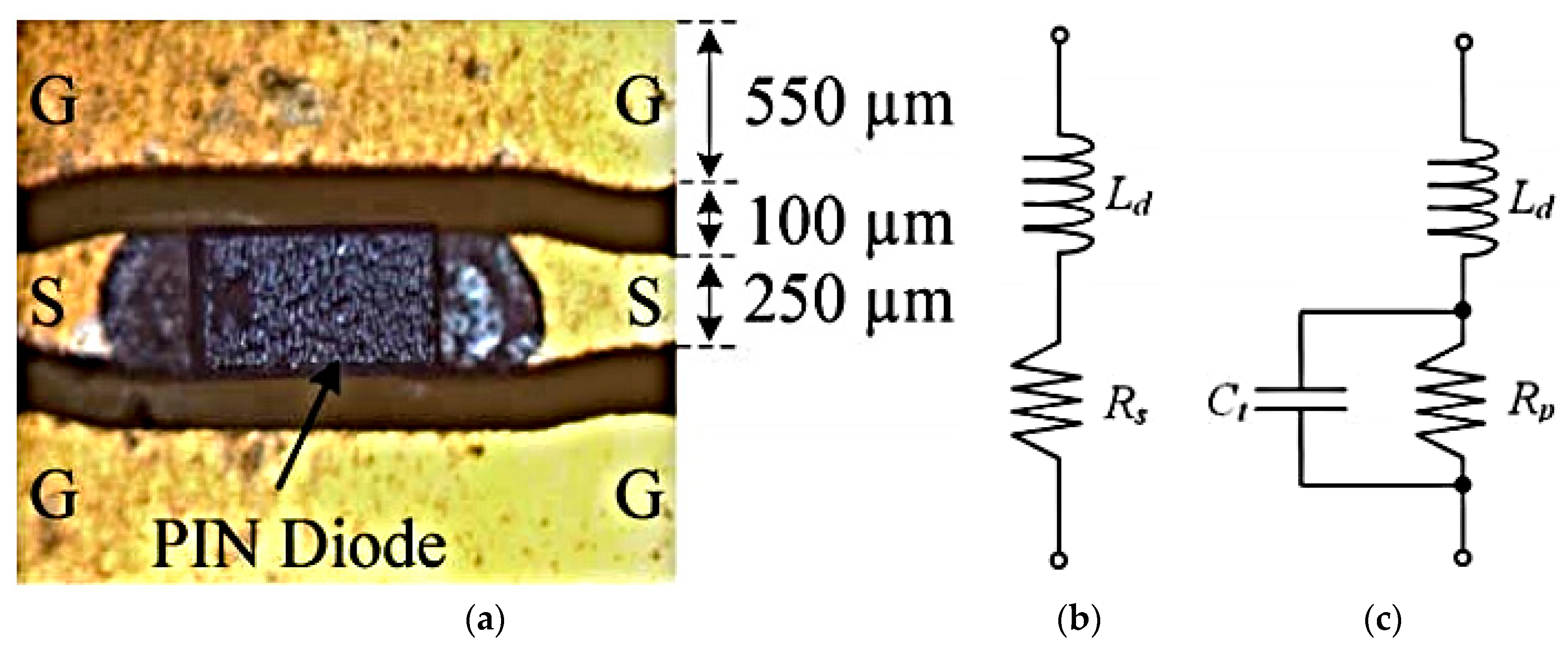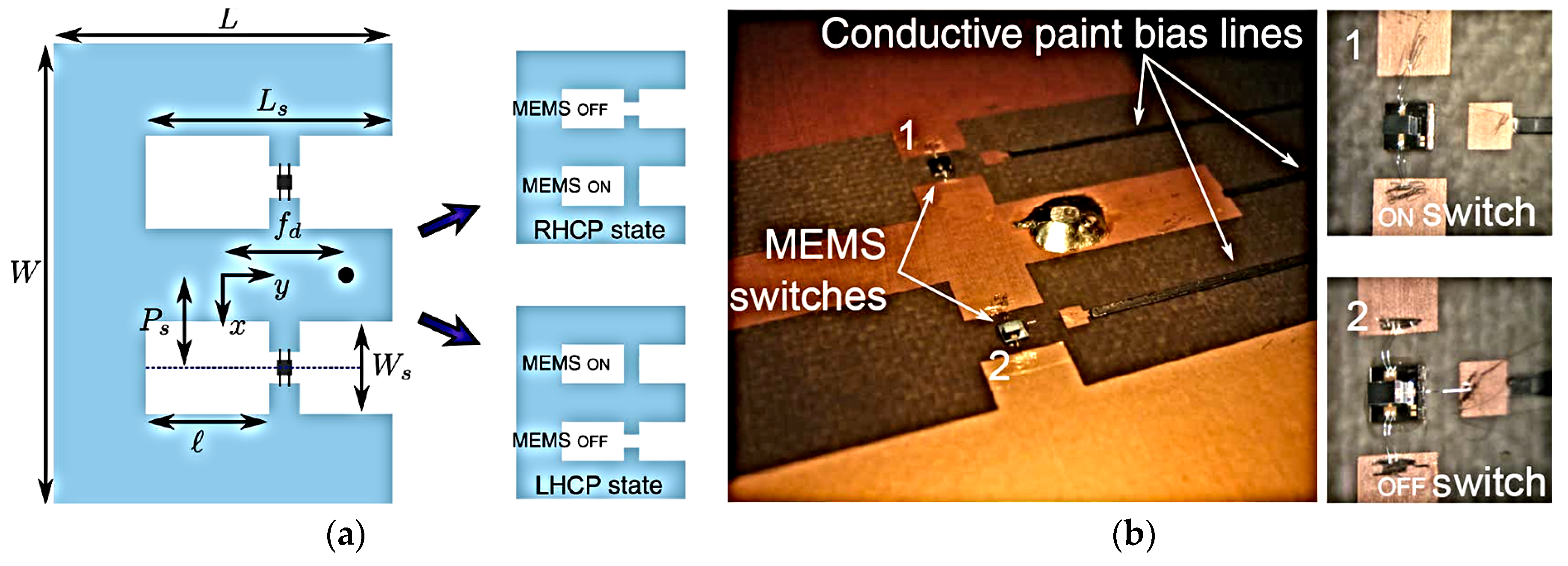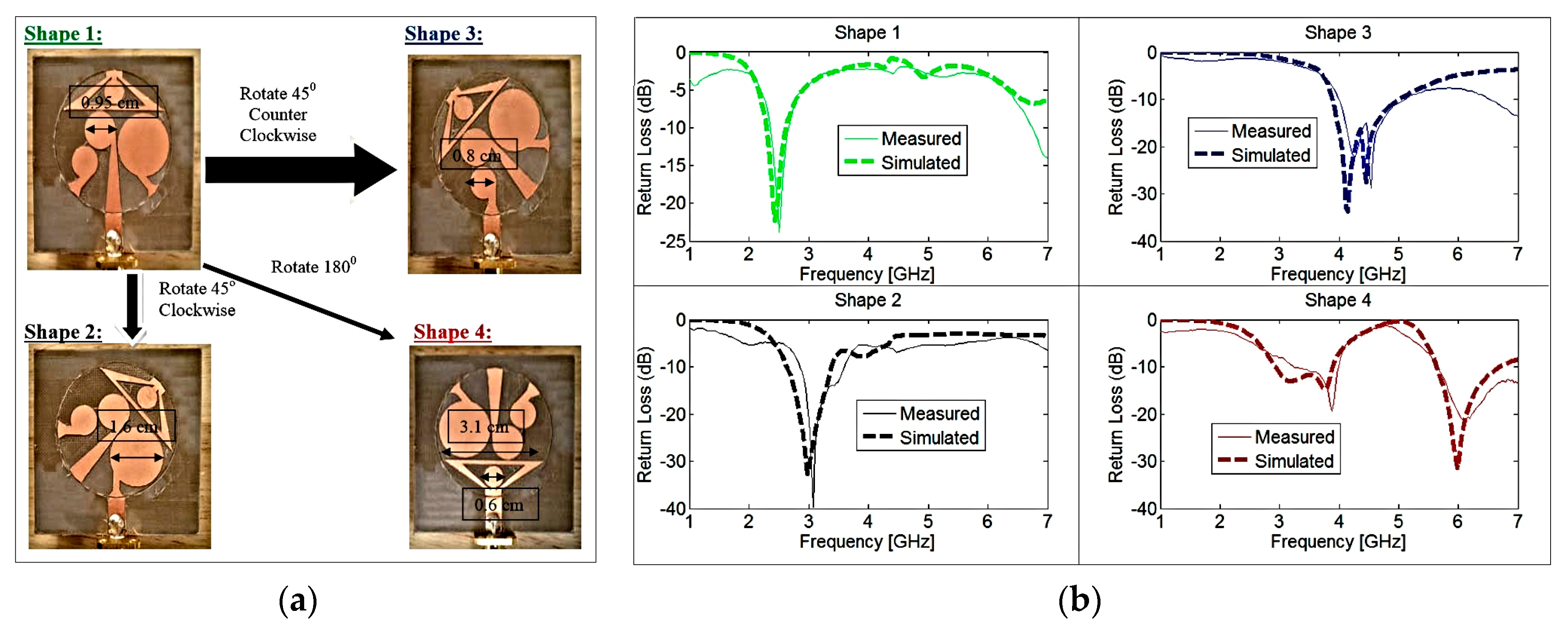Reconfigurable Antennas: Switching Techniques—A Survey
Abstract
:1. Introduction
- Electrical reconfiguration;
- Optical reconfiguration;
- Physical reconfiguration;
- Reconfigurable antennas with smart materials.
2. Electrical Reconfiguration
2.1. PIN Diodes
2.2. Tunable Varactors
2.3. MEMS
3. Optical Reconfiguration
4. Mechanical Reconfiguration
5. Reconfigurable Antennas with Smart Materials
6. Comparison between Different Reconfiguration Techniques
7. Conclusions
Author Contributions
Funding
Acknowledgments
Conflicts of Interest
References
- Bernhard, J.T. Reconfigurable Antennas; Morgan & Claypool Publishers: San Rafael, CA, USA, 2007. [Google Scholar]
- Christodoulou, C.G.; Tawk, Y.; Lane, S.A.; Erwin, S.R. Reconfigurable antennas for wireless and space applications. Proc. IEEE 2012, 100, 2250–2261. [Google Scholar] [CrossRef]
- Balanis, C.A. Antenna Theory Analysis and Design, 4th ed.; John Wiley & Sons: New York, NY, USA, 1998. [Google Scholar]
- Ojaroudi, N.; Amiri, S.; Geran, F. A novel design of reconfigurable monopole antenna for UWB applications. Appl. Comput. Electromagn. Soc. ACES J. 2013, 8, 633–639. [Google Scholar]
- Bernhard, J.T. Reconfigurable Antennas; Wiley: New York, NY, USA, 2005. [Google Scholar]
- Bhartia, P.; Bahl, I.J. Frequency agile microstrip antennas. Microw. J. 1982, 25, 67–70. [Google Scholar]
- Ojaroudi, N.; Amiri, S.; Geran, F. Reconfigurable monopole antenna with controllable band-notched performance for UWB communications. In Proceedings of the 20th Telecommunications Forum, TELFOR 2012, Belgrade, Serbia, 20–22 November 2012. [Google Scholar]
- Musavand, A.; Zehforoosh, Y.; Ojaroudi, H.; Ojaroudi, N. A compact UWB slot antenna with reconfigurable band-notched function for multimode applications. Appl. Comput. Electromagn. Soc. ACES J. 2016, 13, 975–980. [Google Scholar]
- Lu, Z.-L.; Yang, X.-X.; Tan, G.-N. A multidirectional pattern reconfigurable patch antenna with CSRR on the ground. IEEE Antennas Wirel. Propag. Lett. 2017, 16, 416–419. [Google Scholar] [CrossRef]
- Parchin, N.O.; Abd-Alhameed, R.A.; Shen, M. A radiation-beam switchable antenna array for 5G smartphones. In Proceedings of the PhotonIcs & Electromagnetics Research Symposium (PIERS), Xiamen, China, 17–20 December 2019. [Google Scholar]
- Wu, F.; Luk, K.M. Widband tri-polarization reconfigurable magnetoelectric dipole antenna. IEEE Trans. Antennas Propag. 2017, 65, 1633–1641. [Google Scholar] [CrossRef]
- Al-Yasir, Y.I.; Abdullah, A.S.; Ojaroudi Parchin, N.; Abd-Alhameed, R.A.; Noras, J.M. A new polarization-reconfigurable antenna for 5G applications. Electronics 2018, 7, 293. [Google Scholar] [CrossRef] [Green Version]
- Valizade, A.; Ojaroudi, M.; Ojaroudi, N. CPW-fed small slot antenna with reconfigurable circular polarization and impedance bandwidth characteristics for DCS/WiMAX applications. Progress Electromagn. Res. C 2015, 47, 65–72. [Google Scholar] [CrossRef] [Green Version]
- Parchin, N.O.; Abd-Alhameed, R.A.; Shen, M. Frequency-switchable patch antenna with parasitic ring load for 5G mobile terminals. In Proceedings of the International Symposium on Antennas and Propagation (ISAP), Xi’an, China, 27–30 October 2019. [Google Scholar]
- Haupt, R.L.; Lanagan, M. Reconfigurable antennas. IEEE Antennas Propag. Mag. 2013, 55, 49–61. [Google Scholar] [CrossRef]
- Kumar, R.; Vijay, R. Reconfigurable antenna’s: A survey. Int. J. Eng. Dev. Res. 2014, 2, 3090–3099. [Google Scholar]
- Nikopoulos, C.D.; Capsalis, C.N. Reconfigurable antennas: Theory and techniques—A survey. In Wideband, Multiband, and Smart Reconfigurable Antennas for Modern Communications; IGI Global: Hershey, PA, USA, 2016; pp. 203–236. [Google Scholar]
- Sharma, S.; Gupta, M.; Tripathi, C.C. Reconfigurable Antennae: A Review. Int. J. Electr. Commun. Technol. 2011, 2, 131–135. [Google Scholar]
- Ojaroudi Parchin, N.; Jahanbakhsh Basherlou, H.; Al-Yasir, Y.I.; Abd-Alhameed, R.A.; Abdulkhaleq, A.M.; Noras, J.M. Recent developments of reconfigurable antennas for current and future wireless communication systems. Electronics 2019, 8, 128. [Google Scholar] [CrossRef] [Green Version]
- Nikolaou, S.; Bairavasubramanian, R.; Lugo, C.; Carrasquillo, I.; Thompson, D.C. Pattern and frequency reconfigurable annular slot antenna using PIN diodes. IEEE Trans. Antennas Propag. 2006, 54, 439–448. [Google Scholar] [CrossRef]
- Ojaroudi, N.; Ghadimi, N.; Ojaroudi, Y.; Ojaroudi, S. A Novel design of microstrip antenna with reconfigurable band rejection for cognitive radio applications. Microw. Opt. Technol. Lett. 2014, 56, 2998–3003. [Google Scholar] [CrossRef]
- Parchin, N.O.; Al-Yasir, Y.I.A.; Abd-Alhameed, R.A. Microwave/RF Components for 5G Front-End Systems; Avid Science: Telangana, India, 2019. [Google Scholar]
- Andy, A.; Alizadeh, P.; Rajab, K.Z.; Kreouzis, T.; Donnan, R. An optically-switched frequency reconfigurable antenna for cognitive radio applications. In Proceedings of the 10th European Conference on Antennas and Propagation (EuCAP), Davos, Switzerland, 10–15 April 2016; pp. 1–4. [Google Scholar]
- Yazgan, A.; Cakir, O.; Kaya, H.; Cavdar, I.H. Optically reconfigurable fractal antennas for RoF systems. In Proceedings of the International Conference on Telecommunications and signal processing (TSP 2012), Prague, Czech Republic, 2–3 July 2012. [Google Scholar]
- Tawk, Y. Physically controlled CubeSat antennas with an adaptive frequency operation. IEEE Antennas Wirel. Propag. Lett. 2019, 18, 1892–1896. [Google Scholar] [CrossRef]
- Li, C.; Xu, S.; Yang, F.; Li, M. Design and optimization of a mechanically reconfigurable reflectarray antenna with pixel patch elements using genetic algorithm. In Proceedings of the IEEE MTT-S International Wireless Symposium (IWS), Guangzhou, China, 19–22 May 2019. [Google Scholar]
- Singh, A.; Goode, I.; Saavedra, C.E. A multistate frequency reconfigurable monopole antenna using fluidic channels. IEEE Antennas Wirel. Propag. Lett. 2019, 18, 856–860. [Google Scholar] [CrossRef]
- Wang, C.; Yeo, J.C.; Chu, H.; Lim, C.T.; Guo, Y.-X. Design of a reconfigurable patch antenna using the movement of liquid metal. IEEE Antennas Wirel. Propag. Lett. 2018, 17, 974–977. [Google Scholar] [CrossRef]
- Nguyen, B.D.; Pichot, C. Unit-cell loaded with PIN diodes for 1-bit linearly polarized reconfigurable transmitarrays. IEEE Antennas Wirel. Propag. Lett. 2019, 18, 98–102. [Google Scholar] [CrossRef]
- Ojaroudi, S.; Ojaroudi, Y.; Ojaroudi, N. Novel design of reconfigurable microstrip slot antenna with switchable band-Notched Characteristic. Microw. Opt. Technol. Lett. 2015, 57, 849–853. [Google Scholar] [CrossRef]
- Cho, Y.-H.; Rebeiz, G.M. Two- and four-pole tunable 0.7–1.1-GHz bandpass-to-bandstop filters with bandwidth control. IEEE Trans. Microw. Theory Tech. 2014, 62, 457–463. [Google Scholar] [CrossRef]
- Cai, Y. Mars exploration: Wideband frequency reconfigurable electrically small multi-turn loop antenna using MEMS switch. In Proceedings of the IEEE International Symposium on Antennas and Propagation and USNC-URSI Radio Science Meeting, Atlanta, GA, USA, 7–12 July 2019. [Google Scholar]
- Clemente, A.; Dussopt, L.; Sauleau, R.; Potier, P.; Pouliguen, P. 1-bit reconfigurable unit cell based on PIN diodes for transmit-array applications in x-band. IEEE Trans. Antennas Propag. 2012, 60, 2260–2269. [Google Scholar] [CrossRef]
- Mun, B.; Jung, C.; Park, M.-J.; Lee, B. A compact frequency-reconfigurable multiband lte mimo antenna for laptop applications. IEEE Antennas Wirel. Propag. Lett. 2014, 13, 1389–1392. [Google Scholar] [CrossRef]
- Tawk, Y.; Costantine, J.; Christodoulou, C.G. A varactor-based reconfigurable filtenna. IEEE Antennas Wirel. Propag. Lett. 2012, 11, 716–719. [Google Scholar] [CrossRef]
- Jaafar, H.; Sidek, O.; Miskam, A.; Abdul-Rahman, R. High-isolation and low-loss RF MEMS shunt switches. ACES J.-Appl. Comput. Electromagnet. Soc. 2013, 25, 780–786. [Google Scholar]
- Kingsley, N. Comparative study of analytical and simulated doubly-supported RF MEMS switches for mechanical and electrical performance. Appl. Comput. Electromagn. Soc. J. 2006, 21, 9–15. [Google Scholar]
- Kovitz, J.M.; Rajagopalan, H.; Rahmat-Samii, Y. Design and implementation of broadband MEMS RHCP/LHCP reconfigurable arrays using rotated E-shaped patch elements. IEEE Trans. Antennas Propag. 2015, 63, 2497–2507. [Google Scholar] [CrossRef]
- Parchin, N.O.; Al-Yasir, Y.; Abdulkhaleq, A.M.; Elfergani, I.; Rayit, A.; Noras, J.M.; Rodriguez, J.; Abd-Alhameed, R.A. Frequency reconfigurable antenna array for mm-wave 5G mobile handsets. In Proceedings of the International Conference on Broadband Communications, Networks and Systems, Faro, Portugal, 19–20 September 2018. [Google Scholar]
- Rutschlin, M.; Sokol, V. Reconfigurable antenna simulation: Design of reconfigurable antennas with electromagnetic simulation. IEEE Microw. Mag. 2013, 14, 92–101. [Google Scholar] [CrossRef]
- Thummaluru, S.R.; Kumar, R.; Chaudhary, R.K. Isolation and frequency reconfigurable compact MIMO antenna for WLAN applications. Microw. Antennas Propag. 2019, 13, 519–525. [Google Scholar] [CrossRef]
- Ding, Z.; Jin, R.; Geng, J.; Zhu, W.; Liang, X. Varactor Loaded Pattern Reconfigurable Patch Antenna with Shorting Pins. IEEE Trans. Antennas Propag. 2019, 67, 6267–6277. [Google Scholar] [CrossRef]
- Alazemi, A.J. A tunable single-feed triple-band LTE antenna with harmonic suppression. IEEE Access 2019, 7, 104667–104672. [Google Scholar] [CrossRef]
- Pendharker, S.; Shevgaonkar, R.K.; Chandorkar, A.N. Optically controlled frequency-reconfigurable microstrip antenna with low photoconductivity. IEEE Antennas Wirel. Propag. Lett. 2014, 13, 99–102. [Google Scholar] [CrossRef]
- Sathi, V.; Ehtheshami, N.; Nourinia, J. Optically tuned frequency reconfigurable microstrip antenna. IEEE Antennas Wirel. Propag. Lett. 2012, 11, 1018–1020. [Google Scholar] [CrossRef]
- Liu, P.-J.; Zhao, D.-S.; Wang, B.-Z. Design of optically controlled microwave switch for reconfigurable antenna systems. In Proceedings of the International Conference on Microwave and Millimeter Wave Technology, Guilin, China, 18–21 April 2007; pp. 1–4. [Google Scholar]
- Sivakumar, E.; Ramachandran, B.; Indhu bala, B. Optically controlled reconfigurable antenna array. In Proceedings of the International Conference on Communications and Signal Processing (ICCSP), Chengdu, China, 10–11 October 2015; pp. 1839–1843. [Google Scholar]
- Alizadeh, P.; Andy, A.S.; Parini, C.; Rajab, K.Z. A reconfigurable reflectarray antenna in Ka-band using optically excited silicon. In Proceedings of the European Conference on Antennas and Propagation, Davos, Switzerland, 10–15 April 2016; pp. 1–5. [Google Scholar]
- Zheng, S.-H.; Liu, X.-Y.; Tentzeris, M.M. A novel optically controlled reconfigurable antenna for cognitive radio systems. In Proceedings of the IEEE Antennas and Propagation Society International Symposium (APSURSI), Memphis, TN, USA, 6–11 July 2014; pp. 1246–1247. [Google Scholar]
- Da Costa, I.F.; Cerqueira, A.; Spadoti, D.H.; da Silva, L.G.; Ribeiro, J.A.J.; Barbin, S.E. Optically controlled reconfigurable antenna array for mm-wave applications. IEEE Antennas Wirel. Propag. Lett. 2017, 16, 2142–2145. [Google Scholar] [CrossRef] [Green Version]
- Tawk, Y.; Albrecht, A.R.; Hemmady, S.; Balakrishnan, G.; Christodoulou, C.G. Optically pumped frequency reconfigurable antenna design. IEEE Antennas Wirel. Propag. Lett. 2010, 9, 280–283. [Google Scholar] [CrossRef]
- Manasson, V.A.; Sadovnik, L.S.; Yepishin, V.A.; Marker, D. An optically controlled millimeter wave beam-steering antenna based on a novel architecture. IEEE Trans. Microw. Theory Tech. 1997, 45, 1497–1500. [Google Scholar] [CrossRef]
- Patron, D.; Daryoush, A.S.; Dandekar, K.R. Optical control of reconfigurable antennas and application to a novel pattern reconfigurable planar design. J. Lightwave Technol. 2014, 32, 3394–3402. [Google Scholar] [CrossRef]
- Tawk, Y.; Costantine, J.; Ayoub, F.; Christodoulou, C.; Doyle, D.; Lane, S.A. Physically reconfigurable antennas: Concepts and automation. In Proceedings of the IEEE International Symposium on Antennas and Propagation & USNC/URSI National Radio Science Meeting, San Diego, CA, USA, 9–14 July 2017; pp. 419–420. [Google Scholar]
- Ma, W.; Wang, G.; Zong, B.F.; Zhuang, Y.; Zhang, X. Mechanically reconfigurable antenna based on novel metasurface for frequency tuning-range improvement. In Proceedings of the IEEE International Conference on Microwave and Millimeter Wave Technology (ICMMT), Beijing, China, 5–8 June 2016; pp. 629–631. [Google Scholar]
- Jouade, A.; Himdi, M.; Chauloux, A.; Colombel, F. Mechanically pattern-reconfigurable bended horn antenna for high-power applications. IEEE Antennas Wirel. Propag. Lett. 2017, 16, 457–460. [Google Scholar] [CrossRef]
- McMichael, I.T. A mechanically reconfigurable patch antenna with polarization diversity. IEEE Antennas Wirel. Propag. Lett. 2018, 17, 1186–1189. [Google Scholar] [CrossRef]
- Mazlouman, S.J.; Mahanfar, A.; Menon, C.; Vaughan, R.G. Mechanically reconfigurable antennas using electro-active polymers (EAPs). In Proceedings of the IEEE International Symposium on Antennas and Propagation (Apsursi), Spokane, WA, USA, 3–8 July 2011; pp. 742–745. [Google Scholar]
- Huff, G.H.; Pan, H.; Hartl, D.J.; Frank, G.J.; Bradford, R.L.; Baur, J.W. A physically reconfigurable structurally embedded vascular antenna. IEEE Trans. Antennas Propag. 2017, 65, 2282–2288. [Google Scholar] [CrossRef]
- Tawk, Y.; Costantine, J.; Christodoulou, C.G. A frequency reconfigurable rotatable microstrip antenna design. In Proceedings of the IEEE Antennas and Propagation Society International Symposium, Toronto, ON, Canada, 11–17 July 2010; pp. 1–4. [Google Scholar]
- Jang, T.; Zhang, C.; Youn, H.; Zhou, J.; Guo, L.J. Semitransparent and flexible mechanically reconfigurable electrically small antennas based on tortuous metallic micromesh. IEEE Trans. Antennas Propag. 2017, 65, 150–158. [Google Scholar] [CrossRef]
- Zhu, H.; Cheung, S.; Yuk, T. Mechanically pattern reconfigurable antenna using metasurface. Microw. Antennas Propag. 2015, 9, 1331–1336. [Google Scholar] [CrossRef]
- Washington, M.A.G.; Yoon, H.-S.; Theunissen, W.H. Design, modeling, and optimization of mechanically reconfigurable aperture antennas. IEEE Trans. Antennas Propag. 2002, 50, 628–637. [Google Scholar] [CrossRef]
- Yang, X.; Xu, S.; Yang, F.; Li, M.; Fang, H.; Hou, Y.; Liu, L. A mechanically reconfigurable reflectarray with slotted patches of tunable height. IEEE Antennas Wirel. Propag. Lett. 2018, 17, 555–558. [Google Scholar] [CrossRef]
- Mehdipour, A.; Denidni, T.A.; Sebak, A.R.; Trueman, C.W.; Rosca, I.D.; Hoa, S.V. Mechanically reconfigurable antennas using an anisotropic carbon-fibre composite ground. IET Microw. Antennas Propag. 2013, 7, 1055–1063. [Google Scholar] [CrossRef]
- Liu, P.; Yang, S.; Wang, X.; Yang, M.; Song, J.; Dong, L. Directivity reconfigurable wideband two-arm spiral antenna. IEEE Antennas Wirel. Propag. Lett. 2016, 16, 66–69. [Google Scholar] [CrossRef]
- Jiao, Y.; Young, C.W.; Yang, S.; Oren, S.; Ceylan, H.; Kim, S.; Dong, L. Wearable graphene sensors with microfluidic liquid metal wiring for structural health monitoring and human body motion sensing. IEEE Sens. J. 2016, 16, 7870–7875. [Google Scholar] [CrossRef]
- Aljonubi, K.; AlAmoudj, A.O.; Langle, R.J.; Reane, I. Reconfigurable antenna using smart material. In Proceedings of the 7th European Conference on Antennas and Propagation (EuCAP), Gothenburg, Sweden, 8–12 April 2013. [Google Scholar]
- Teeslink, T.S.; Torres, D.; Ebel, J.L.; Sepulveda, N.; Anagnostou, D.E. Reconfigurable bowtie antenna using metal-insulator transition in vanadium dioxide. IEEE Antennas Wirel. Propag. Lett. 2015, 14, 1381–1384. [Google Scholar] [CrossRef]
- Wang, M.; Kilgore, I.M.; Steer, M.B.; Adams, J.J. Characterization of intermodulation distortion in reconfigurable liquid metal antennas. IEEE Antennas Wirel. Propag. Lett. 2018, 17, 279–282. [Google Scholar] [CrossRef]
- Zhang, G.B.; Gough, R.C.; Moorefield, M.R.; Cho, K.J.; Ohta, A.T.; Shiroma, W.A. A liquid-metal polarization-pattern-reconfigurable dipole antenna. IEEE Antennas Wirel. Propag. Lett. 2018, 17, 50–53. [Google Scholar] [CrossRef]
- Hu, Z.; Wang, S.; Shen, Z.; Wu, W. Broadband polarization reconfigurable water spiral antenna of low profile. IEEE Antennas Wirel. Propag. Lett. 2017, 16, 1377–1380. [Google Scholar] [CrossRef]
- Wang, S.; Zhu, L.; Wu, W. A novel frequency-reconfigurable patch antenna using low-loss transformer oil. IEEE Trans. Antennas Propag. 2017, 65, 7316–7321. [Google Scholar] [CrossRef]
- Ojaroudi, N. Design of small reconfigurable microstrip antenna for UWB-CR applications. In Proceedings of the 19th International Symposium on Antenna and propagation, ISAP2014, Kaohsiung, Taiwan, 2–5 December 2014. [Google Scholar]
- Ojaroudi, N.; Ojaroudi, M. A novel design of reconfigurable small monopole antenna with switchable band notch and multi resonance functions for UWB application. Microw. Opt. Technol. Lett. 2013, 55, 652–656. [Google Scholar] [CrossRef]
- Zhao, D.; Lan, L.; Han, Y.; Liang, F.; Zhang, Q.; Wang, B.Z. Optically controlled reconfigurable band-notched UWB antenna for cognitive radio applications. IEEE Photon. Technol. Lett. 2014, 26, 2173–2176. [Google Scholar] [CrossRef]
- Zheng, S.H.; Liu, X.; Tentzeris, M.M. Optically controlled reconfigurable band-notched UWB antenna for cognitive radio systems. Electron. Lett. 2014, 50, 1502–1504. [Google Scholar] [CrossRef] [Green Version]
- Panagamuwa, C.J.; Chauraya, A.; Vardaxoglou, J.C. Frequency and beam reconfigurable antenna using photoconductive switches. IEEE Trans. Antennas Propag. 2006, 54, 449–454. [Google Scholar] [CrossRef] [Green Version]
- Cummings, N.P. Active Antenna Bandwidth Control Using Reconfigurable Antenna Elements. Ph.D. Thesis, Virginia Tech, Bradley Department of Electrical and Computer Engineering, Blacksburg, VA, USA, 2003. [Google Scholar]
- Rohde, U.L.; Newkirk, D.P. RF/Microwave Circuit Design for Wireless Applications; Wiley: New York, NY, USA, 2000. [Google Scholar]
- Mazlouman, S.J.; Mahanfar, A.; Menon, C.; Vaughan, R.G. A review of mechanically reconfigurable antennas using smart material actuators. In Proceedings of the European Conference on Antennas and Propagation (EUCAP), Rome, Italy, 11–15 April 2011; pp. 1076–1079. [Google Scholar]
- Sanchez-Olivares, P.; Masa-Campos, J.L. Mechanically reconfigurable conformal array antenna fed by radial waveguide divider with tuning screws. IEEE Trans. Antennas Propag. 2017, 65, 4886–4890. [Google Scholar] [CrossRef]
- Song, L.; Gao, W.; Chui, C.O.; Rahmat-Samii, Y. Wideband frequency reconfigurable patch antenna with switchable slots based on liquid metal and 3-D printed microfluidics. IEEE Trans. Antennas Propag. 2019, 67, 2886–2895. [Google Scholar] [CrossRef]
- Chen, Z.; Wong, H.; Kelly, J. A polarization-reconfigurable glass dielectric resonator antenna using liquid metal. IEEE Trans. Antennas Propag. 2019, 67, 3427–3432. [Google Scholar] [CrossRef]
- Wang, M.; Khan, M.R.; Dickey, M.D.; Adams, J.J. A compound frequency- and polarization- reconfigurable crossed dipole using multidirectional spreading of liquid metal. IEEE Antennas Wirel. Propag. Lett. 2016, 16, 79–82. [Google Scholar] [CrossRef]










| Reconfiguration Technique | Advantages | Disadvantages |
|---|---|---|
| PIN-Diodes |
|
|
| Varactors |
|
|
| RF MEMS |
|
|
| Switch Types | Voltage [V] | Current [mA] | Power [mW] | Isolation | Loss [dB] | Speed [µsec] |
|---|---|---|---|---|---|---|
| PIN Diode | 3–5 | 3–20 | 5–100 | High | 0.3–1.2 | 1–100 ×10−6 |
| MEMS | 20–100 | 0 | 0.05–0.1 | Very High | 0.05-0.2 | 1–200 |
| Optical (Si) | 1.8–1.9 | 0–87 | 0–50 | High | 0.5–1.5 | 3–9 |
| Reconfiguration Technique | Advantages | Disadvantages |
|---|---|---|
| Electrical Reconfiguration |
|
|
| Optical Reconfiguration |
|
|
| Mechanical Reconfiguration |
|
|
| Smart-Materials-Based Reconfiguration |
|
|
© 2020 by the authors. Licensee MDPI, Basel, Switzerland. This article is an open access article distributed under the terms and conditions of the Creative Commons Attribution (CC BY) license (http://creativecommons.org/licenses/by/4.0/).
Share and Cite
Ojaroudi Parchin, N.; Jahanbakhsh Basherlou, H.; Al-Yasir, Y.I.A.; M. Abdulkhaleq, A.; A. Abd-Alhameed, R. Reconfigurable Antennas: Switching Techniques—A Survey. Electronics 2020, 9, 336. https://doi.org/10.3390/electronics9020336
Ojaroudi Parchin N, Jahanbakhsh Basherlou H, Al-Yasir YIA, M. Abdulkhaleq A, A. Abd-Alhameed R. Reconfigurable Antennas: Switching Techniques—A Survey. Electronics. 2020; 9(2):336. https://doi.org/10.3390/electronics9020336
Chicago/Turabian StyleOjaroudi Parchin, Naser, Haleh Jahanbakhsh Basherlou, Yasir I. A. Al-Yasir, Ahmed M. Abdulkhaleq, and Raed A. Abd-Alhameed. 2020. "Reconfigurable Antennas: Switching Techniques—A Survey" Electronics 9, no. 2: 336. https://doi.org/10.3390/electronics9020336
APA StyleOjaroudi Parchin, N., Jahanbakhsh Basherlou, H., Al-Yasir, Y. I. A., M. Abdulkhaleq, A., & A. Abd-Alhameed, R. (2020). Reconfigurable Antennas: Switching Techniques—A Survey. Electronics, 9(2), 336. https://doi.org/10.3390/electronics9020336









